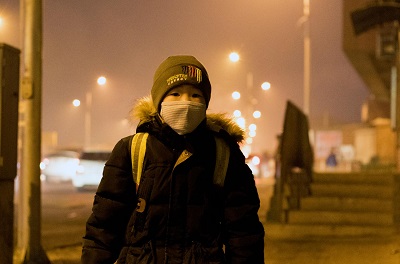Mongolia’s air pollution causes child health crisis
Unless Ulaanbaatar’s air pollution levels rapidly decrease in the coming years, the financial cost of treating diseases in children caused by air pollution will increase by 33 per cent by 2025, costing an additional MNT 4.8 billion per annum to the public health system from 2025, reveals a new report commissioned by the Mongolian National Center for Public Health and UNICEF.

A boy waiting for his bus to a local school in Songinokhairkhan district where the air pollution level is dangerously high.
Mongolia’s air pollution crisis: A call to action to protect children’s health raises the alarm about the impact of air pollution on child health care and calls for urgent action to prevent and treat health problems among children, and reduce the extremely high levels of toxic air.
In winter months, air pollution in Ulaanbaatar – where a half of the country’s children reside – is among the highest in the world. On 30 January 2018, air pollution exceeded 133 times the international safe limit set by the World Health Organization. The measurement was taken at a monitoring station at Baruun 4 zam where PM2.5 pollution reached 3,320 micrograms per cubic meter.
In last 10 years, incidences of respiratory diseases in Ulaanbaatar have increased dramatically. Cases of respiratory infections have nearly tripled and pneumonia is now the second leading cause of death for children under five years old. Children living in the highly polluted district of central Ulaanbaatar were found to have 40 per cent lower lung function than children living in a rural area.
In addition to health issues, emerging evidence suggests that breathing in particulate air pollution can damage brain tissue and undermine cognitive development in babies and young children – leading to lifelong implications and setbacks.
“Air pollution has become a child health crisis in Ulaanbaatar, putting every child and pregnancy at risk. The risks include stillbirth, preterm birth, lower birth weight, pneumonia, bronchitis, asthma, inhibited brain development and death. It is a real threat to Mongolia’s human capital,” said UNICEF Mongolia Representative Alex Heikens.
“Reducing air pollution levels is the only long term sustainable solution to protecting children’s health. In the meantime, thousands of children will continue to suffer unless urgent action is taken. We need urgent investment in cleaner and more efficient energy, immediate reduction in children’s exposure, better treatment to children afffected by diseases, and support children’s overall health to reduce their vulnerability to air pollution“.
The report recommends the following to reduce the impact of air pollution on children’s health:
- Strengthen public education campaigns to raise awareness and improve understanding of the health consequences of air pollution, protection measures, use of clean technology and fuels, and early recognition of respiratory diseases among children.
- Increased coverage of the Pneumococcal Vaccine.
- Improve indoor air quality in public kindergartens, schools and hospitals where children spend considerable amount of time.
- Provide guidance to the public on the use and access to good quality face masks.
Source:United Nations Children's Fund
- 270 reads
Human Rights
Ringing FOWPAL’s Peace Bell for the World:Nobel Peace Prize Laureates’ Visions and Actions

Protecting the World’s Cultural Diversity for a Sustainable Future

The Peace Bell Resonates at the 27th Eurasian Economic Summit

Declaration of World Day of the Power of Hope Endorsed by People in 158 Nations

Puppet Show I International Friendship Day 2020

